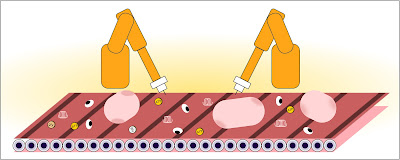Session September 2022: "Giant bacteria and the evolution of eukaryotes"
Talks "The role of mitochondrial energetics in the origin and diversification of eukaryotes" and "Thiomargarita magnifica, the largest bacterium ever observed is a complex macroscopic single-cell"
In our September Forum on "Giant bacteria and the evolution of eukaryotic cells", Sergio Muñoz-Gómez presented theoretical predictions of feasible cell sizes for bacteria and eukaryotes, which he had recently published with our panel discussant Paul Schavemaker. Their work concerns limits on cells size that are relevant for eukaryote evolution and our understanding of the role of mitochondria (both as carriers of DNA and as a powerful source of “cheap” energy via respiration). As a concrete case that both challenges and confirms the theory, Jean-Marie Volland presented the recently discovered giant bacteria Thiomargarita magnifica, which are up to 2 centimeters long and can have 500.000 copies of their DNA.
Sergio’s and Paul’s work refers to a 2010 paper “The energetic of genome complexity” [1] by Lane and Martin, who tried to explain why eukaryotes could evolve to large and complex cells and who postulated that mitochondria are the reason for the evolution to sophisticated structures due to two main reasons:
1- Energy per gene available. The extra energy produced by mitochondria allows eukaryotes to have around 5000 times more metabolic power per Mb of DNA than prokaryotes. In other words, requiring the protein synthesis about 75% of the overall energy of a cell, the amount of protein to be produced (i.e. genes to be expressed) is bounded by the energy availability in the cell. Scaling ATP production with the membrane surface, and protein synthesis with the cell’s volume, follows that mitochondria increases of 10^5-10^6 times the energy per gene available.
2 - Mitochondrial DNA. Mitochondria contains genes that encode for the respiratory electron-transport chain, and this allows for rapid responses in case of changes in membrane potential. Furthermore, to have a replica of mitochondria not all the whole genome has to be copied as it happens in prokaryotes.
In their own work [2], Sergio and Paul analyzed and corrected these assumptions finding the exact boundaries to size and gene complexity for prokaryotes. To define when prokaryotes become surface-area constrained, a formula for the computation of the respiratory deficit is proposed. This equation is a function of the cell shape, cell division time and maximum respiratory membrane fraction. It follows that larger cells do not necessarily experience energy shortage if they have a long division time and extensive intracytoplasmic membrane, as it happens to Thiomargarita nambiensi. Secondly the concept of energy per gene is criticized and a precise formula is proposed to determine the energetic advantage of the asymmetric genome architecture of eukaryotes over the symmetric architecture of prokaryotes. (Eukaryotes have both a single nuclear genome and many small and specialized mitochondrial genomes that scale with cell volume. Therefore asymmetric.). From the computations it follows that the energetic advantage of eukaryotes over prokaryotes never exceeds 200% (three-fold). Such a result is derived considering the features of “modern” eukaryotes, which evolved in time. It is likely that the first proto-eukaryotes had a much less energetic advantage. It follows that Eukaryotes only gained an energetic advantage after their mitochondrial genomes reduced considerably and their main genome copy number was no longer required to scale with cell volume.
Afterward, Jean-Marie introduced the newly discovered giant bacteria Thiomargarita magnifica, validating Sergio’s results on the feasibility, under special conditions, for bacteria to reach eukaryotes-like dimension.
Thiomargarita magnifica has been found in mangrove sulfidic marine environment in Guadalupe and presents itself as centimeter long filament. At the beginning each thread was thought to be an ensemble of cells, but after several tests it was confirmed that each filament is a single cell, composed of a very thin external layer of cytoplasm while the internal part is filled with liquid (Figure 1). The employment of advanced imaging techniques (FISH and correlative TEM, as well as membrane and DNA staining, immunohisto-chemistry, and BONCAT), revealed important physiological features of the membrane and DNA.
Firstly, the DNA and ribosomes are contained in a new type of membrane-bound organelle, called pepins. This compartmentalization is reminiscent of the genomic nuclear compartmentalization in eukaryotes.
Secondly, T. magnifica is polyploid (it contains several genome copies) with an average of 36000 genome copies per millimeter of filament. All genome copies are highly similar to each other and about 25% of the genes are dedicated to second metabolism. Furthermore, it was observed that many genes encoding core cell division protein are lacking, vice versa the genes encoding for cytoskeletal protein (i.e. elongation) are well conserved. In other words, Thiomargarita magnifica rather elongates than divides. Offspring cells originate from the terminal buds of the filament, though only a small fraction of the genome copies present within pepins in the apical bud (≈1%) are transmitted to the daughter cell. BONCAT analysis showed that the protein synthesis is active in the whole cell and not only at the extremity. In addition, ATP synthases are distributed around pepins and throughout the complex membrane network of the entire cytoplasm, but they are absent from the outer cell envelope.
In conclusion, thanks to slow growth, extensive respiratory membrane fraction, and an unusual cytoplasm shape, T. magnifica confirms the feasibility for bacteria to reach high dimension and complexity.
Interesting fact: T. magnifica has a genome as large as the baker’s yeast Saccharomyces cerevisiae (12.1 Mb).
Does the large size of Thiomargarita magnifica contradict Sergio’s theory? At first sight, this seems to be the case. But as Paul Schavemaker told us in the discussion, to apply the theory, one needs to consider Thiomargarita magnifica’s effective size: the size of a “normally shaped” bacterium with the same membrane to volume ratio; while this “effective” Thiomargarita magnifica would still be much bigger than a bacterium such as E. coli, it would still fall in the predicted feasible range of bacterial cell sizes.
References
[1] Lane, N., Martin, W. The energetics of genome complexity. Nature 467, 929–934 (2010). https://doi.org/10.1038/nature09486
[2] Sergio Muñoz-Gómez and Paul Schavemaker, The role of mitochondrial energetics in the origin and diversification of eukaryotes. Nature Ecology & Evolution (2022) 6(9):1-11, DOI:10.1038/s41559-022-01833-9
[3] Jean-Marie Volland et al, A centimeter-long bacterium with DNA contained in metabolically active, membrane-bound organelles, Science (2022), Vol 376, Issue 6600, pp. 1453-1458
Further links:
- https://jgi.doe.gov/giant-bacteria-found-in-guadeloupe-mangroves-challenge-traditional-concepts
- https://www.science.org/content/article/largest-bacterium-ever-discovered-has-unexpectedly-complex-cells
- https://en.wikipedia.org/wiki/Thiomargarita_magnifica
Thanks to
- Speakers: Jean-Marie Volland (Laboratory for Research in Complex Systems) and Sergio A. Muñoz-Gómez (Université Paris-Saclay)
- Panel discussant: Paul Schavemaker (Center for Mechanisms of Evolution, Arizona State University)
- Organizer: Wolfram Liebermeister
- Bloggers: Giulia Slaviero, Hamza Faquir, Christian Fernández Pérez



Comments
Post a Comment